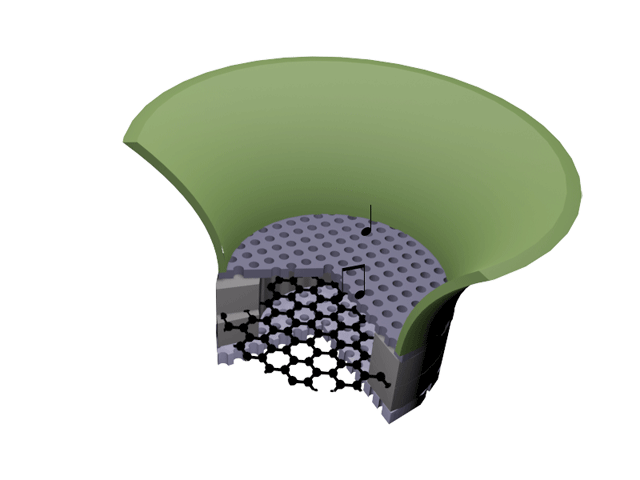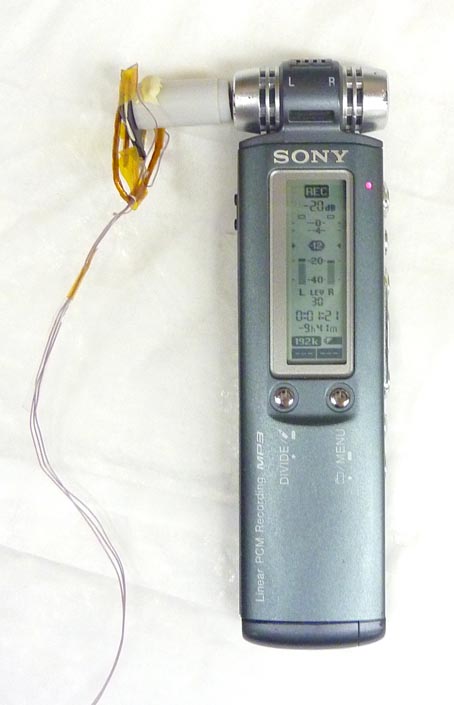Zettl Group Page |
Research Highlights
|
 |

|  |
 |
 |
 |
Electrostatic Graphene Loudspeaker
Qin Zhou and A. ZettlDepartment of Physics, University of California at Berkeley
Materials Sciences Division, Lawrence Berkeley National Laboratory
Center of Integrated Nanomechanical Systems, University of California at Berkeley
Berkeley, CA 94720, U.S.A.
The following media files are intended for public access, and may be reproduced as long as proper credit is given: "Courtesy Zettl Research Group, Lawrence Berkeley National Laboratory and University of California at Berkeley." All rights reserved © 2013.
Introduction
Efficient audio sound transduction has a history dating back millions of years. Primitive insect singers generate loud and pure-tone sound with high efficiency by exciting resonators inside their body. Male crickets generate chirping sounds via stridulation, where the scraper edge of one wing is rubbed against the ribbed edge of the other wing. Advantageous structural properties of the wings (relatively large, low-mass flexural membranes) allow extremely efficient muscle-to-sound energy transduction. In a human context, unnatural (i.e. non-voice) sound production has been explored for millennia, with classic examples being drumheads and whistles for long-range communications and entertainment. In modern society, efficient small-scale audio transduction is ever more important for discrete audio earphones and microphones in portable or wireless electronic communication devices.
For human audibility, an ideal speaker or earphone should generate a constant sound pressure level (SPL) in the frequency range from 20 Hz to 20 kHz, i.e. it should have a flat frequency response. Most speakers available today reproduce sound via a mechanical diaphragm, which is displaced oscillatorily during operation. The diaphragm, with inherent mass, restoring force (i.e. spring constant), and damping, essentially constitutes a simple harmonic oscillator. Unlike most insect or musical instrument resonators which exhibit lightly-damped sharp frequency response, a wide-band audio speaker typically requires significant damping to broaden the response. Unfortunately, "damping engineering" quickly becomes complex and expensive, with inevitable power inefficiencies.
An alternative approach to response spectrum broadening is to reduce both the mass and spring constant of the diaphragm so that inherent air damping dominates and flattens the response peaks. Moreover, with ambient air serving as the dominant damping mechanism, most input energy is converted to a sound wave, which makes such speakers highly power efficient. For these reasons, the ideal audio transduction diaphragm should have small mass and a soft spring constant, and be non-perforated to efficiently displace the surrounding air. Electrostatically-driven thin-membrane loudspeakers employing an electrically conducting, low-mass diaphragm with significant air damping have been under development since the 1920's (the first were made of pig intestine covered with gold-leaf), but miniaturized electrostatic earphones are still rare. One key reason is that the per-area air damping coefficient significantly decreases when the size of the diaphragm falls below the sound wavelength. Hence, for small speakers a thinner and lower mass density diaphragm is required to continue the dominance of air damping. Such a diaphragm is difficult to realize. If conventional materials such as metalized mylar are made too thin, they invariably fatigue and break.
Graphene is an ideal building material for small, efficient, high-quality broad-band audio speakers because it satisfies all the above criteria. It is electrically conducting, has extremely small mass density, and has been used to construct mechanical resonators. Here we demonstrate the construction of a miniaturized graphene-based electrostatic loudspeaker with excellent frequency response across the entire region for human ear, with performance matching or surpassing commercially available audio earphones.
Additional information can be found in a feature article in MIT Technology Review, found here.
Illustrations
If you use any of the following images, please include the credit "Courtesy Zettl Research Group, Lawrence Berkeley National Laboratory and University of California at Berkeley."
 |
|
 |
|
 |
|
 |
|
 |
An artist's rendering of the EDGS animation (mp4 format)
|
Recordings
If you use any of the following media or images, please include the credit "Courtesy Zettl Research Group, Lawrence Berkeley National Laboratory and University of California at Berkeley."
The following recording is made in the following condition:
The source files are 128 kbps mp3 music files, played through Creative® Audigy ZS2 sound card,
voltage amplified by ~30x using operational amplifiers (AD797), played through EDGS, and recorded by a close-by
SONY® ICD-SX700 Digital Voice Recorder. The raw left channel recordings are compressed into 128 kbps mp3 files.

|
Recordings of songs played through EDGS
Somebody that I used to know, by Gotye (128kbps mp3 format)
|
Acknowledgements
This work was supported in part by the Director, Office of Energy Research, Office of Basic Energy Sciences, Materials Sciences and Engineering Division, of the U.S. Department of Energy under Contract No. DE-AC02-05CH11231, which provided for graphene growth and characterization; by the Office of Naval Research under grant No. N00014-09-1066, which provided for graphene transfer and electrode manufacture, and by the National Science Foundation under Grant No. EEC-083819, which provided for design, construction, and testing of the device. The authors thank Yung-Kan Chen and Prof. David Bogy for assistance with LDV measurements.
External Links
The original arXiv article published online on March 10, 2013.
Last modified: Mon April 9 18:45:00 Pacific Daylight Time 2013